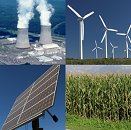According to a recent report released by the Energy Information Administration, 2007 saw renewable energy sources, other than conventional hydroelectric capacity, accounting for the largest portion of capacity additions.
Net generation produced by renewable energy sources, excluding hydroelectric generation, increased by 9.0 percent as compared to 10.5 percent growth in 2006.
Renewable energy accounted for 2.5 percent or 105 million MWh of total net generation in 2007. Wood and wood derived fuels accounted for the lion’s share and wind power was the second largest renewable energy source, contributing 34 million MWh or 0.8 percent of total net generation. In 2007, wind accounted for nearly a third of total net generation from non-hydroelectric renewable sources, as compared to 4.3 percent in 1997.
Geothermal power plants supplied 15 million MWh of net generation and other biomass 17 million MWh during 2007. Solar power now accounts for 0.5 percent of all non-hydroelectric renewable energy.
While the news is cause for some celebration, unlike 2006, when carbon dioxide declined, carbon dioxide emissions from conventional electric generation and combined heat and power plants increased 2.3 percent in 2007, showing that the USA still has a very long way to go in terms of even getting to a point where power generation emissions can be stabilized long term. In 2007, electricity generation from coal-fired capacity increased 1.3 percent, reversing the decline from 2005 to 2006.
The three primary energy sources for generating electric power in the United States are coal, natural gas, and nuclear energy, providing between 84.6 and 89.5 percent of total net generation during the period 1997 through 2007. While emissions intensive coal remains the primary source of baseload generation, its overall market share is in slow decline as cleaner technologies gain a foothold. The challenge remains that electricity demand is outstripping the speed of implementation of new renewable energy capacity, something that US President Barack Obama has pledged to address during his presidency.












































